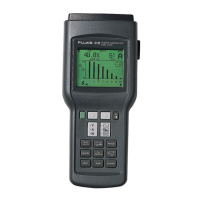39/41B
Service Manual
2-12
Table 2-4 is a truth table for the selection of the various devices in the Tester.
Table 2-4. Logic Truth Table
Device Signal A4 A5 A14 A15 DS* PS* XY
SRAM CS_SRAM 0 0
SRAM CS_SRAM 0 1 0
EEPROM CS_EEPROM 1 0 1 1
EPROM CS_BOOTROM 1 0
LCD CS_LCD 0 1 1 1 0 0
EEPOT INC_EEPOT 0 1 1 1 0 0
EEPOT CS_EEPOT 1 1 1 1 0 0
LATCH CS_GAIN 1 0 1 1 0 0
2-30. Interface to LCD Module
The LCD module requires a clock sync signal “E” that synchronizes all read and write
operations. It signals the display module that all address, data, and control signals are
valid, with an active high state. This signal is generated from U2 signals WR*, RD*,
DSPCLOCK, and CS_LCD*. This generated “E” signal is active high during a
read/write operation between the DSP and the LCD module.
2-31. Shift Register
The amps and volts readings are sampled simultaneously to avoid phase errors. The a/d
data for both input channels is transferred to the DSP over a single serial port. The PLD
shift register stores an amps data point while the DSP is reading the associated volts data
point.. After the volts data point has been read into the serial port, the data from the shift
register (amps data) is clocked out and read. This process repeats until the until the
appropriate number of samples have been read.
2-32. Serial Multiplexer
There are three sources of serial data; the volts a/d converter, the shift register holding
the amps data input, and the serial EEPROM (U22). The DSP signals the PLD
multiplexer to select one of the three sources and feed that source (DOUT) to the single
serial port on the DSP.
2-33. EEPOT (Contrast Control) Interface
The EEPOT interface of the PLD provides the chip select (CS_EEPOT*) and the control
(INC_EEPOT*) signals for the EEPOT. The signal that controls the direction of the
wiper comes directly from the DSP. Reading or writing to address location Y:$FFE0
enables CS_EEPOT and strobes the INC_POT signal. After the correct value is reached,
location Y:$FFF0 is read or written to clear the CS_EEPOT, which writes the value into
the EEPOT.

